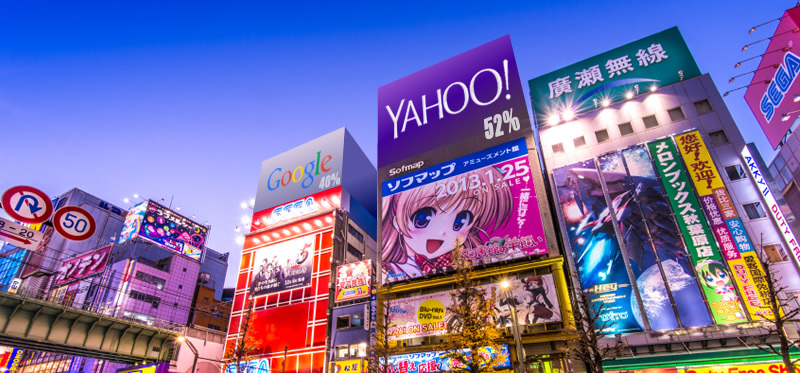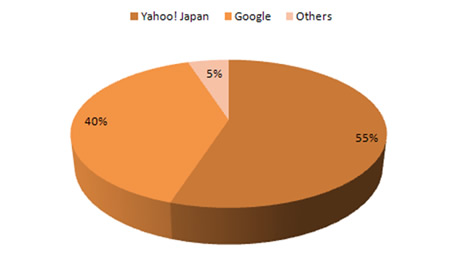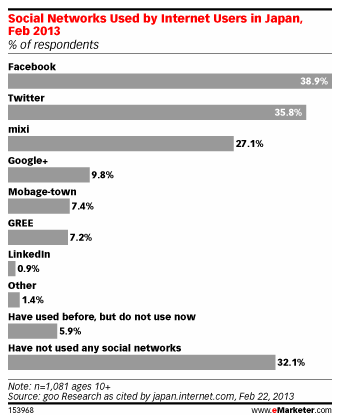Search engine statistics are pretty elusive for Japan but there is light at the end of the tunnel!
So what is the most popular search engine in Japan?
Yahoo! Japan is very much powered by Google’s algorithm so I’d say focus on Google’s main ranking factors if you want to enter the Japanese market successfully. There are various important algorithm factors we could take into consideration while undertaking SEO in Japan which I’ll cover below.
Domain and hosting – go local
A familiar fact is that search engines give more value to websites hosted on local web servers. Hosting your website locally, as well as having local ccTLDs will give you a significant advantage to rank in Japan. It is an important geo-targeting indicator of trust and local authority to search engines.
There are a few writing styles used when searching in Japanese. Let’s use keyword “travel” as an example:
- Latin: ryokou
- Kanji: 旅行
- Hiragana: りょこう
- Katakana: リョコウ
The above keywords all have the same meaning however, unless using a Japanese keyboard, users normally type in Latin characters first before converting them into their preferred Japanese writing style. If your website focuses on a niche product, consider using Latin characters (e.g. ryokou) in your domain name – this will give you a better chance of ranking well for domain name terms.
URL – the shorter the better
Ensure that your URLs are UTF-8 encoded. Encoding your URLs to UTF-8 standard simply means converting them from text strings into URL format. Google understands Japanese characters and displays them properly in SERPs if they have been correctly encoded, even though you might see a long string of weird characters in your browser. Do bear in mind that some servers limit the length of URL, such as Internet Explorer which renders 2083 characters. A good guideline would be that URLs should never be longer than 2048 characters so that all browsers including IE can read them. Winner!
It’s all about localisation…
Consider using Japanese character keywords in subfolders, if they draw more search volume. For example, www.example.co.jp/folder1/ここにキーワード.html. This will give you a better chance of ranking for your target keywords.
Other good URL practices are very similar to Google. Avoid using session IDs or CGI parameters on URLs, ensure that they are unique and permanent, use hyphens “-” to separate keywords in URLs as well as ensuring that the structure of your URL does not exceed more than three levels.
E.g. http://www.example.co.jp/level1/level2/level3.html
Title
Title tags are one of the fundamentals of on-page SEO elements, in any part of the world. A good guideline for a title tag is that it should not exceed 70 characters, to avoid search engines truncating it in the search results page and you should place your most important keyword close to the front of the title tag. As Japanese users see trust as an important element of an online presence, consider placing your brand name at the end of the title tag. This will help to raise brand awareness and create a good click-through rate for users who are familiar with your brand.
Content – get your audience right
Content is the most important element of SEO. Good quality content should always be written specifically for a Japanese audience and not translated directly from existing content. This includes localising the website’s template that is characteristically designed to adapt to the Japanese e-commerce style. Contact forms are important to bring leads to your business. Ensure that your contact forms are designed using localised terms to avoid having high bounce rate on this page. A common example that is often found on contact forms is the term “zip code” which is usually derived from American English content translation. “Zip code” is not a common term used in Japan and this will cause users to question if the site is reliable. To sum up, as long as the process of making a conversion fits the “Japanese” style, whether your KPIs are queries or sales is an absolute winner.
As mentioned earlier, trust is important in Japan so foreign companies especially may want to invest more in your company’s profile page, as a way of gaining trust from users. You could start with an “About Us” or “Our Achievements” page that displays the achievements and experience of your company.
The Japanese are used to seeing a lot of information displayed, so don’t be put off from including lots of content on your pages. It is a different approach to the other side of the world – where less text, more engaging information and straight-to-the-point content are more common.
As always, avoid having thin and duplicated pages. If you must, use canonical tags on duplicated pages to avoid being penalised by the search engines or regarded as spam. Interactive approaches such as videos and infographics are always successful when it comes to engaging visitors to your website.
Other important HTML elements such as H1s, H2s, alt tags and anchor texts are equally important although you also should consider the speed of a page load.
Links
Yahoo! Japan places more weight on directory listings than any other search engine. So whenever you optimise pages with keywords, consider submitting them to relevant local directories. Ideally, focus on building backlinks originating from Japanese IP addresses, local domains, local hosting as well as from websites that contains Japanese content. Building links using non-local links is less effective in Japan.
You may also want to consider getting links from business affiliates that you already have a relationship with. Getting quality backlinks from these affiliates is one of the many good methods of signalling trust to search engines.
Once again, content is everything. Create engaging content to attract links.
Social media
The screenshot below shows this year’s statistics from emarketer.com. Mixi was once a very popular social network in Japan but users are slowly moving to Facebook and Twitter over time. Facebook and Twitter now have the closest competition in Japan.
On another note, NicoVideo is a very popular video sharing website in Japan. Although YouTube is equally popular in Japan, the opportunities of reaching your target audience using NicoVideo are great.
Another interesting social community tool to engage users is Yahoo! Chiebukuro (Yahoo! 知恵袋). It is commonly known as Yahoo! Answers in Western countries. Users share their interests, opinions and knowledge in topics here, a slightly similar approach to Naver Café in Korea although it doesn’t have an account for followers to subscribe to.
Japanese SEO checklist
- Host your website on a local web server.
- Use a local ccTLD for your website domain (.jp).
- Have a short, UTF-8 encoded URL.
- Consider using Japanese character keywords in subfolders, if they draw more search volume.
- Title tags should not exceed 70 characters.
- Consider placing your brand name at the end of the title tag.
- Create high quality content from scratch in Japanese.
- Consider asking business affiliates to link to your website.
- Utilise social media – Facebook and Twitter are particularly popular.
To conclude
In a nutshell, go local! Know your target audience and trust the advice from Japanese natives and specialists, even if they have a completely different approach to your global team.
Lyn Kan
Latest posts by Lyn Kan (see all)
- Key Considerations For Effective International Content Creation - March 20, 2014
- SEO in Japan: An essential guide to Japanese search success - December 12, 2013











Nice article! Localization is time consuming. I am trying to market https://muread.com/ja in Japan, that provides news links in multiple languages. Backlinks are important, but I still have no idea where to build them.
nice post. what about a multilingual site like http://www.wiFicallingiPhone.com, how can we rank such blog in Japan. will backlinks alone do the magic?
Nice and understanable article! I just don´t know which keyword type I have to put on keyword list. Is better to use all shape of keyword? Latin, katakana, hiragana and kanji.
Thank you
Hi Petr,
Indeed we recommend to include all Japanese scripts in a keyword research. For latin ones I would think it depends whether you are able to include them on the page (for SEO that is).
Thank you for your post! I have learned much from it, but may I ask a question? Our company focuses on developing iOS software (desktop software), and I found that about 40% of audiences are visiting our websites from mobile devices. Because our software is based on computer, so we have to find a way to drive those mobile traffic to computer, or they are useless. By the way, the mobile traffic’s bounce rate is much higher than desktop traffic. So how should we do to take use of the mobile traffic? Hope you can give me an answer, thanks a lot!
It was really interesting. Thank you!!
Nice article, I wouldn’t say it is the essential guide as plenty more areas to discuss. Yet some good pieces of information which I took out of this article.
Great article and thanks for all of the information!
I’ve spent lots of time trying to optimise my website (about a small English school south of Chiba) for my local community but I can’t seem to even be noticed by google or yahoo. My traffic is almost non-existent.
Most of the information on the web in English is for American businesses and although I speak and read quite a bit of Japanese it’s hard to find the information I’m looking for even in English.
Anyway, I was just happy to come across your article and wanted to say thanks.
Keep up the great work.
Thank you Jesse. I hope that it would help bringing more traffic to your website.
[…] gleich. Dennoch gibt es ein paar Besonderheiten zu beachten, welche ein neuer Artikel auf webcertain.com hervorhebt: So wird empfohlen, einen Domain-Namen in lateinischer Schrift, Unterordner jedoch mit […]